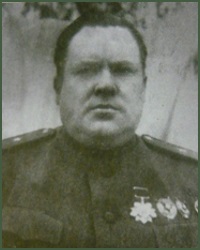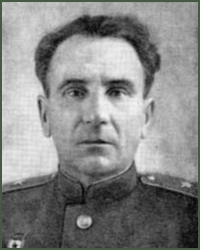| 27th Army | |
|---|---|
| Active |
|
| Country | |
| Branch | Red Army |
| Type | Field Army |
| Engagements | World War II |
| Commanders | |
| Notable commanders | Nikolai Berzarin |
The 27th Army was a field army of the Soviet Union's Red Army, which fought in World War II.
| 27th Army | |
|---|---|
| Active |
|
| Country | |
| Branch | Red Army |
| Type | Field Army |
| Engagements | World War II |
| Commanders | |
| Notable commanders | Nikolai Berzarin |
The 27th Army was a field army of the Soviet Union's Red Army, which fought in World War II.
The 27th Army was formed in May 1941, under the command of Major General Nikolai Berzarin. On 22 June 1941 it consisted of the 22nd and 24th Territorial Rifle Corps, the 16th and 67th Rifle Divisions, 3rd Separate Rifle Brigade, two artillery regiments, and two anti-tank regiments. [1] It became part of the Northwestern Front on the outbreak of Operation Barbarossa, fighting in the Soviet defense of the Baltic, known in Soviet historiography as the Baltic Strategic Defensive Operation.
From June to October 1941 the 27th Army fought on the Dvina River, during the Staraya Russa Offensive, and at Kholm and Demyansk. By 1 November 1941 the army's forces had been reduced to the 23rd and 33rd Rifle Divisions, the 613th Artillery Regiment of the Reserve of the Supreme High Command (RVGK), the 28th Tank Division, and three Battalions of engineers. [2]
In December 1941 the first formation of the army was renamed the 4th Shock Army.
The army reformed in May 1942, within the Northwestern Front, consisting of five rifle divisions. In April 1943 it was moved into Stavka reserve. From July 1943, it participated in many famous battles, assigned to the Steppe Front, then the Voronezh Front, in the Belgorod-Kharkov operation and the Bukrin bridgehead. From October 1943, it fought in the Kiev offensive (with 1st Ukrainian Front). Thereafter, assigned to the 2nd and 3rd Ukrainian Front, it was part of the Zhitomir–Berdichev Offensive, the Korsun–Shevchenkovsky Offensive, the Uman-Botosani Offensive, the Iassy-Kishinev Offensive, the Battle of Debrecen, and the Vienna Offensive. [3]
After the end of the war, it was ordered withdrawn to Romania by 20 August 1945, and concentrated in the areas of Brăila, Buzău, and Galați in eastern Romania. By November it included the 33rd (78th, 206th, and 337th Rifle Divisions) and the 37th Rifle Corps (163rd, 316th, and 320th Rifle Divisions), as well as the 35th Guards Rifle Corps (66th, 108th, and the 125th Guards Rifle Divisions). Shortly afterwards, the 27th Army was withdrawn to the Carpathian Military District. [4] There, its headquarters was disbanded on 4 August 1946, [5] and its three rifle corps were directly subordinated to the district headquarters. [6]
The 4th Mechanized Corps was a formation in the Soviet Red Army during the Second World War.
A rifle corps was a Soviet corps-level military formation during the mid-twentieth century. Rifle corps were made up of a varying number of rifle divisions, although the allocation of three rifle divisions to a rifle corps was common during the latter part of World War II.
The 75th Guards Rifle Division was a Red Army infantry division during World War II and afterwards, which later became the 75th Guards Tank Division and was finally disbanded in the 1990s.

The 51st Army was a field army of the Red Army that saw action against the Germans in World War II on both the southern and northern sectors of the front. The army participated in the Battle of the Kerch Peninsula between December 1941 and January 1942; it was destroyed in May 1942 with other Soviet forces when the Wehrmacht launched an operation to dislodge them from the peninsula. The army fought in the Battle of Stalingrad during the winter of 1942–43, helping to defeat German relief attempts. From late 1944 to the end of the war, the army fought in the final cutting-off of German forces in the Courland area next to the Baltic. Inactivated in 1945, the army was activated again in 1977 to secure Sakhalin and the Kuril Islands. Following the dissolution of the Soviet Union, the army continued in existence as a component of the Russian Ground Forces. The army was active during two periods from 1941 until 1997.
The 270th Rifle Division was a Red Army infantry division formed twice during World War II, in 1941 and 1942.
The 22nd Army was a field army of the Red Army during World War II.

The 20th Army was a field army of the Red Army that fought on the Eastern Front during World War II.
The 52nd Army was a field army of the Red Army of the Soviet Union in World War II, formed twice.
The 26th Rifle Division was a rifle division in the Soviet Red Army during the Russian Civil War, World War II and the Cold War. The division was formed on 3 November 1918 on the Eastern Front, sent to the Soviet-German Front in August 1941. Ended the war in Poland, where it was assigned to the Northern Group of Forces. It was disbanded in 1952.
The 11th Tank Division was a Soviet tank division initially formed in 1940 at Tiraspol and destroyed in 1941; it was then formed as a tank corps in May 1942. This unit was subsequently reorganized as the second formation of the 11th Tank Division in 1945.
The 109th Rifle Division was a Red Army infantry division that was formed three times, briefly in 1939, during 1942, and again from 1942-45. The first formation of the division was converted to a mechanized division after about nine months. Its second formation served for six months in 1942 in the defense of the fortress of Sevastopol, in the southern sector of the siege lines. After being destroyed there in July, a third division was formed by re-designating an existing rifle division near Leningrad in August, and it successfully held its positions for nearly a year and a half, in spite of shortages of food and supplies due to the German/Finnish siege. The 109th then participated in the offensive that drove the Germans away from the city in early 1944, helped drive Finland out of the war, and then joined the offensive along the Baltic coast towards Germany. This third formation compiled an admirable record of service, but was disbanded in 1946.

The 310th Rifle Division was a standard Red Army rifle division formed on July 15, 1941 in Kazakhstan before being sent to the vicinity of Leningrad, where it spent most of the war, sharing a similar combat path with its "sister", the 311th Rifle Division. The soldiers of the division fought until early 1944 to, first, hold open some sort of lifeline to the besieged city, then to break the siege and drive off the besieging German forces. They then participated in the offensive that drove Germany's Finnish allies out of the war. Finally, the division was redeployed to take the fight to the German heartland in the winter and spring of 1945. It ended the war north of Berlin with a very creditable combat record for any rifle division.

The 334th Rifle Division was formed in August 1941, as a standard Red Army rifle division in the Volga Military District. For most of the war it followed a very similar combat path to that of the 332nd Rifle Division, sometimes serving on adjacent sectors. It fought in the Battle of Moscow and during the winter counteroffensive was assigned to 4th Shock Army, where it would remain until November 1943. During this offensive it helped carve out the Toropets Salient, where it would remain until the autumn of 1943 when it helped to liberate Velizh and began advancing westward again. In the first days of the 1944 summer offensive the 334th shared credit with several other units in the liberation of Vitebsk and was awarded that name as an honorific. The unit advanced into East Prussia in January 1945, distinguishing itself in the siege of the heavily-fortified city of Königsberg and the clearing of the Baltic coast. It continued to serve briefly into the postwar period.
The 291st Rifle Division was an infantry division of the Soviet Union's Red Army during World War II. Formed in the summer of 1941, the 290th fought in the siege of Leningrad until its end in January 1944, and then in the Baltic states, Poland, Germany, and Czechoslovakia before being disbanded after the end of the war in the summer of 1945.
The 267th Rifle Division was an infantry division of the Soviet Union's Red Army during World War II.
The 347th Rifle Division began forming in mid-September, 1941, as a Red Army rifle division, in the North Caucasus Military District. It was soon assigned to the 58th Army while both it and its Army continued to form up before entering combat in November, as part of the offensive that first liberated Rostov-on-Don. During the German summer offensive in 1942 the division retreated back into the Caucasus, fighting to defend the routes to the oil fields at Baku, until the German forces began to retreat after their defeat at Stalingrad. During 1943 and early 1944 it continued to serve in the southern part of the front, taking part in the liberation of Crimea, before being transferred to the Baltic States region, serving in Latvia and Lithuania for the duration of the war, compiling a distinguished record of service along the way. In 1946 it was reformed as a rifle brigade, and its several successor formations remained part of the Red Army until 1959, when it was finally disbanded.
The 265th Motor Rifle Division was a motorized infantry division of the Soviet Army during the Cold War.
The 263rd Rifle Division was an infantry division of the Red Army during World War II.
The 4th Guards Motor Rifle Division was a motorized infantry division of the Soviet Army during the Cold War.
The 364th Rifle Division was an infantry division of the Red Army during World War II.